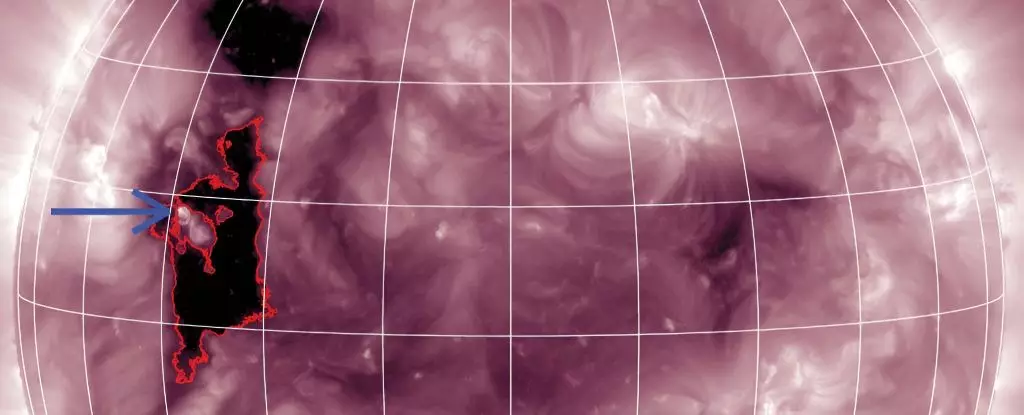In a remarkable astronomical revelation, a significant event transpired in late October 2023, spotlighting the Sun’s dynamic and often unpredictable nature. A colossal hole in the Sun’s atmosphere was discovered, which became the source of an unprecedented release of helium-3, a rare isotope not commonly found in large quantities. This occurrence has caught the attention of astronomers worldwide, with implications that could reshape our understanding of solar phenomena and isotope rarity in the universe.
Contrary to the typical understanding of our Sun as a provider of helium-4, which constitutes roughly a quarter of normal cosmic matter, this event emphasized the Sun’s capacity to produce helium-3 in staggering quantities. Helium-3, constituting roughly 0.002% of the solar wind, saw its concentration skyrocket to levels 180,000 times greater than average due to a highly concentrated solar jet escaping from a coronal hole. This anomaly raises intriguing questions about the processes occurring within our star’s atmosphere and their potential implications for space science.
The Science Behind Solar Jets
Astrophysicist Radoslav Bučík, alongside his colleagues at the Southwest Research Institute, has delved deeply into these findings. Their study highlights how solar jets, which are narrow streams of plasma launched from the Sun’s surface, can preferentially accelerate helium-3 due to its favorable charge-to-mass ratio. This suggests that lighter isotopes can be propelled at much higher velocities compared to their heavier counterparts during solar ejections. Such jets are normally associated with energetic outbursts, often featuring a mix of heavier elements like iron; however, this event’s unique composition prompts a reevaluation of previous assumptions.
The significance of these observations cannot be understated, as they hint at broader themes of cosmic evolution and the behavior of elements forged in the aftermath of the Big Bang. What sets this particular solar jet apart is not merely the quantity of helium-3 but the absence of substantial amounts of heavier elements such as iron, typically found during similar solar events. This peculiarity might suggest that certain regions of the solar atmosphere, while appearing robust, might, in fact, have less magnetic turbulence and different elemental compositions than expected, allowing for unique isotopes to thrive.
Coronal Holes: The Gateways to Understanding Solar Phenomena
The coronal hole from which this helium-3 was expelled plays a crucial role in understanding the Sun’s behavior. These transient features form due to gaps in the Sun’s magnetic field and allow solar wind to escape more freely. They appear notably darker in ultraviolet and X-ray images owing to their cooler and less dense nature compared to the surrounding corona. During the period of this extraordinary helium-3 expulsion, scientists observed a strikingly large coronal hole, which enabled a swift release of solar particles.
There is a tantalizing connection between the magnetic field dynamics in these regions and the occurrence of solar jets. Bučík’s assertion that the magnetic strength of the area was atypically weak, mirroring conditions found in more tranquil solar environments rather than active hotspots, propels new theories concerning the enrichment of helium-3. This relationship suggests that the turbulence typically associated with more active solar regions may inhibit the optimal conditions required for helium-3 to accumulate.
Implications for Solar Research
The implications of this solar event are multifaceted. First and foremost, the abundance of helium-3 could offer insights into the fundamental processes driving solar activity and the behavior of isotopes under various cosmic conditions. Furthermore, the fact that helium-3 appears to be produced in high concentrations without the typical accompaniment of heavier elements challenges existing models of solar physics, suggesting that what we have perceived as the norm may merely be one facet of a larger, intricate process.
Given that scientists can directly observe phenomena from the Solar Orbiter, which resides at a pivotal point between Earth and the Sun, data collection will likely improve our comprehension of these violent solar phenomena. The Solar Orbiter’s privileged vantage point presents an exciting opportunity to track such rare solar particle events, leading to enhanced predictions and understanding of space weather that affects not just our planet but the broader solar system.
As we investigate this cosmic anomaly, it will be crucial for researchers to determine whether such helium-3 rich solar events are rare or simply overlooked. As science continues to uncover the mysteries cloaked within our Sun’s atmosphere, the conditions out of which these elements emerge may hold answers to the evolution of our entire solar system.


Leave a Reply